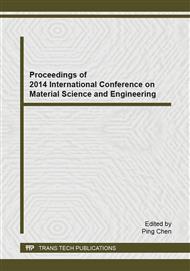[1]
G.F. Fanta, R.C. Burr, Copolymers of starch I copolymerization of gelatinized wheat starch with acrylonitrile: Fractionation of copolymer and effect of solvent on copolymer composition. Journal of Applied Polymer Science. 10(1966) 929-937.
DOI: 10.1002/app.1966.070100610
Google Scholar
[2]
G.F. Fanta, R.C. Burr, Copolymers of starch II copolymerization of gelatinized wheat starch with acrylonitrile: influence of reaction conditions on copolymer composition. Journal of Applied Polymer Science. 10(1966) 765-769.
DOI: 10.1002/pol.1966.110041018
Google Scholar
[3]
G.F. Fanta, R.C. Burr, Copolymers of starch III copolymerization of gelatinized wheat starch withacrylonitrile: Influence of chain modifiers on copolymer composition. Journal of Applied Polymer Science. 11 (1967) 457-463.
DOI: 10.1002/app.1967.070110312
Google Scholar
[4]
B.N. Lin, The study of new type super absorbent of starch graft copolymerization. Journal of the Chinese Cereals and Oils Association. 3 (1995) 36-46.
Google Scholar
[5]
S.B. Li, Synthesis and Evaluation of PAA/AM Water Absorbent Resin. Coatings Painting & Electroplating. 3(2005) 21-24.
Google Scholar
[6]
X.R. Liu, Absorbency and Adsorption of Poly(acrylate-co-acrylamide) by Solution Polymeri- zation. Hunan xiangtan: xiangtan university. 6(2006).
Google Scholar
[7]
A. Li, A.Q. Wang, Synthesis and properties of clay-based superabsorbent composite. Europe Polymer Journal. 41 (2005) 1630-1637.
DOI: 10.1016/j.eurpolymj.2005.01.028
Google Scholar
[8]
Z.Y. Jia, Y.D. Cui, XM. Li, and G. Q. Yin, ProgressinModificationof Poly-AA-Na Super- Absorbent polymer. Chemical Industry and Engineering Progress. 23 (2004) 468-471.
Google Scholar
[9]
J.J. Xie, H.G. Wu, J.X. Jiang, and G.P. Tu, Absorbency and adsorption of PAAs in salt solutions of heavy metal ions. Journal of Functional Materials. 38(2007) 1331-1333.
Google Scholar
[10]
C. Kavakli, S. A Tuncel, and B. Salih, Selectivity of cyclam modified poly(p-chloromethyl styrene-ethyleneglycol dimethacrylate) microbeads for Cu( II), Ni( II), Co(II) and Zn(II) . Seperation Purification Technology. 45 (2005) 32-40.
DOI: 10.1016/j.seppur.2005.02.007
Google Scholar
[11]
Y. Bao, J.Z. Ma, and H. Li, preparation and properties of super absorbent acrylic resin. Journal of Functional Materials. 4 (2011) 693-695.
Google Scholar
[12]
T. Wan, W.Q. He, Y. Yuan, and H.Q. Ding, Study on Kaolinite composite water super absorbent by water solution polymerization. China Elastomerics. (2004) 43-46.
Google Scholar
[13]
X.H. Zhang, B.J. Cui, andY.D. Cui, Synthesis and Characterization of Poly(sodium acrylate)/ Kaolin superabsorbent Composite. Fine Chemicals, 20 (2003) 584-588.
Google Scholar
[14]
Y.L. He, The property parameters and testing method of Superabsorbent polymers. New Chemical Materials. 26 (1998) 22-24.
Google Scholar
[15]
W.T. Liang, X.H. Zheng, and W, P. Zou, Research on the Orthogonal Experiment for CBM Drilling Fluid Formulation. China Coalbed Methane. 6 (2009) 38-43.
Google Scholar
[16]
H. Tang, F. Yang, and Y. Chen, Orthogonal experimental optimum analysis for preparation of complex oagulant PSFA from fly ash. Journal of anhui institute of engineering technology: natural science edition. 1 (2009) 6-9.
Google Scholar
[17]
X.R. Wang, J. Jiao, Z.X. Qu, and J. Sun, Study on redox initiators in acrylic emulsion polymerization and adhesive. China Adesives. 15 (2006) 1-4.
Google Scholar
[18]
R. Meena, K. Prasad, G. Mehta, Synthesis of the copolymer hydrogel κ- carrageenan graft -PAAm: Evaluation of its absorbent and adhesive properties. Journal of applied polymer science. 102 (2006) 5144-5152.
DOI: 10.1002/app.24703
Google Scholar


